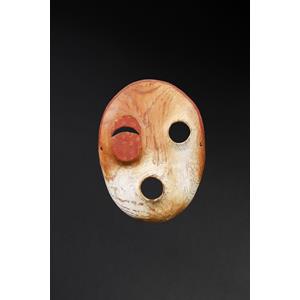IMAGE DETAILS

Galerie Flak
Yup'ik shaman mask
Carved wood, pigments
Coastal Yup’ik - Eskimo, St Michael or Yukon river Delta, Alaska, 19th century
H 19.5 cm
Provenance: Karin & Leo (1937-1987) Van Oosterom collection, The Hague, acquired in 1980
Yup’ik masks from Alaska are exceedingly rare in both museum collections and private hands, as most were created for ceremonies and intentionally destroyed or discarded after use - a reflection of their deep spiritual significance.
Ancient art from Alaska holds a crucial place in the history of modern art. Far from being isolated expressions of ritual life, these masks and sculptures profoundly shaped the visual vocabulary of the European avant-garde. Their abstract forms, shifting identities, and spiritual intensity deeply resonated with Surrealist artists, inspiring them to explore new dimensions of imagination, metamorphosis, and the unconscious.
This captivating and poetic example of Eskimo shamanic art depicts a powerful tunghak spirit, intricately blending human and animal features with celestial motifs. The left eye is round and wide open, while the right eye - partially closed and painted red, adorned with white dots - evokes a sense of mystery. The crescent-shaped, winking eye on a red background with white dots may symbolize the moon and stars, while the round eye represents the sun.
In the Eskimo spirit world, tunghat (singular: tunghak) are powerful, mythical beings who dwell on the moon yet roam widely. Known as “Keepers of the Game,” they control the availability of fish and animals. They often regard humans with suspicion, seeing them as intruders who hunt their protected creatures or offend them through disrespectful acts. Only the shaman could perceive and communicate with these spirits, who frequently tested or deceived him. At times, the shaman had to fly to the moon to implore the tunghak to act on humanity’s behalf. A core role of the shaman was to appease the spirits of game animals, treating them with reverence after death to demonstrate the community’s good intentions.
According to Jean-Loup Rousselot (Masques esquimaux d’Alaska, Éditions Amez, 1991), the supernatural energy of the tunghak is concentrated in its eye. Its vision is amplified by numerous white dots - additional “eyes” that sharpen its awareness of human behavior. The eye-dot motif is a recurring feature not only on masks but also on ceremonial regalia and the painted bodies of dancers.



 download image
download image